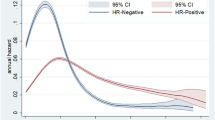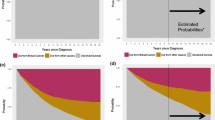Abstract
Objective
Breast cancer mortality has been declining in many countries including Canada because of improvements in survival. This study attempts to explain observed trends in breast cancer survival with special attention given to the role of improvements in early detection and treatment.
Methods
This study is based on 4,312 women diagnosed with primary invasive breast carcinoma treated in a Canadian breast center between 1976 and 2000 and followed to the end of 2001. Observed and relative survival rates were calculated. Multivariate relative survival regression models were used to assess trends in breast cancer survival over the study period.
Results
The proportion of women with small tumors (≤10 mm) was higher in late 1990s, while that of women with regional involvement was lower compared to earlier periods. Adjuvant chemotherapy or endocrine therapy use increased steadily from 6.6% to 84.0% during the study period. Five-year relative survival rates ranged between 82.1% and 83.7% between 1976 and 1990, and increased thereafter to reach 87.6% in 1991–95, and 92.1% in 1996–2000. During the first five years after diagnosis, women diagnosed in 1991–95 and 1996–2000 experienced a reduction in breast cancer mortality of 28% (Relative Risk (RR)= 0.72; 95% CI: 0.59–0.89) and 49% (RR = 0.51; 95% CI: 0.39–0.68) respectively compared to women diagnosed in 1976–90. Improvement in breast cancer survival in 1990’s could not be explained by characteristics of women, biology of the tumor, advancements in early detection and type of initial treatments.
Conclusion
A substantial increase in breast cancer survival was observed in the 1990s but the reasons for this improvement remain elusive. Better knowledge of these reasons could help not only to further reduce the burden related to breast cancer but also the burden related to other major cancer sites.

Similar content being viewed by others
References
Institut national de cancer du Canada. Statistiques canadiennes sur le cancer 2004. Toronto, Canada, avril 2004
Bray F, McCarron P, Parkin DM (2004) The changing global patterns of female breast cancer incidence and mortality. Breast Cancer Res 6:229–239
Ries LAG, Eisner MP, Kosary CL et al. SEER Cancer Statistics Review, 1975–2002, National Cancer Institute. Bethesda, MD, http://seer.cancer.gov/csr/1975_2002/, based on November 2004 SEER data submission, posted to the SEER web site 2005
Surveillance, Epidemiology, End Results (SEER) Program (www.seer.cancer.gov) SEER*Stat Database: Mortality – All COD, Public-Use With State, Total U.S. (1969–2002), National Cancer Institute, DCCPS, Surveillance Research Program, Cancer Statistics Branch, released April 2005. Underlying mortality data provided by NCHS (www.cdc.gov/nchs)
Levi F, Lucchini F, Negri E et al (2004) Trends in mortality from major cancers in the European Union, including acceding countries, in 2004. Cancer 101:2843–2850
Surveillance, Epidemiology, End Results (SEER) Program (www.seer.cancer.gov) SEER*Stat Database: Incidence – SEER 9 Regs Public-Use, Nov 2004 Sub (1973–2002), National Cancer Institute, DCCPS, Surveillance Research Program, Cancer Statistics Branch, released April 2005, based on the November 2004 submission
Louchini R, Beaupré M La survie reliée au cancer pour les nouveaux cas déclarés au Québec, de 1984 à 1998: Survie observée et survie relative, 2003
Demers A, Turner D, Mo D et al (2005) Breast cancer trends in Manitoba: 40 years of follow-up. Chronic Dis Can 26:13–19
Ugnat AM, Xie L, Semenciw R et al (2005) Survival patterns for the top four cancers in Canada: the effects of age, region and period. Eur J Cancer Prev 14:91–100
Statistique Canada Statistiques sur la survie 2005. http://www.statcan.ca/francais/freepub/84–601-XIF/2005001/survival_f.htm. Access date: August 2005
Ellison LF, Gibbons L (2004) Leading cancers–changes in five-year relative survival. Health Rep 15:19–32
Coleman MP, Gatta G, Verdecchia A et al (2003) EUROCARE-3 summary: cancer survival in Europe at the end of the 20th century. Ann Oncol 14 Suppl (5):v128–v149
Kobayashi S (2004) What caused the decline in breast cancer mortality in the United Kingdom? Breast Cancer 11:156–159
Jatoi I, Miller AB (2003) Why is breast-cancer mortality declining? Lancet Oncol 4:251–254
Quinn MJ (2003) Cancer trends in the United States–a view from Europe. J Natl Cancer Inst 95:1258–1261
Bloom HJ, Richardson WW (1957) Histological grading and prognosis in breast cancer; a study of 1409 cases of which 359 have been followed for 15 years. Br J Cancer 11:359–377
Elston CW, Ellis IO (1991) Pathological prognostic factors in breast cancer. I. The value of histological grade in breast cancer: experience from a large study with long-term follow-up. Histopathology 19:403–410
Lawless JF (1982) Statistical models and methods for lifetime data. Wiley series in probability and mathematical statistics. New York: John Wiley and Sons
Ederer F, Axtell LM, Cutler SJ (1961) The relative survival rate: a statistical methodology. Natl Cancer Inst Monogr 6:101–121
Surv3: Relative survival analysis program. Software Malual Program version 3.01. Helsinki: Finnish Cancer Registry
Howell A, Cuzick J, Baum M et al (2005) Results of the ATAC (Arimidex, Tamoxifen, Alone or in Combination) trial after completion of 5 years’ adjuvant treatment for breast cancer. Lancet 365:60–62
Berrino F, Esteve J, Coleman MP (1995) Basic issues in estimating and comparing the survival of cancer patients. IARC Sci Publ:1–14
Gamel JW, Vogel RL (2001) Non-parametric comparison of relative versus cause-specific survival in Surveillance, Epidemiology and End Results (SEER) programme breast cancer patients. Stat Methods Med Res 10:339–352
Capocaccia R, Gatta G, Roazzi P et al (2003) The EUROCARE-3 database: methodology of data collection, standardisation, quality control and statistical analysis. Ann Oncol 14 Suppl (5):v14–v27
MacMahon S, Collins R (2001) Reliable assessment of the effects of treatment on mortality and major morbidity, II: observational studies. Lancet 357:455–462
Louwman WJ, Janssen-Heijnen ML, Houterman S et al (2005) Less extensive treatment and inferior prognosis for breast cancer patient with comorbidity: a population-based study. Eur J Cancer 41:779–785
Read WL, Tierney RM, Page NC et al (2004) Differential prognostic impact of comorbidity. J Clin Oncol 22: 3099–3103
Houterman S, Janssen-Heijnen ML, Verheij CD et al (2004) Comorbidity has negligible impact on treatment and complications but influences survival in breast cancer patients. Br J Cancer 90:2332–2337
Nagel G, Wedding U, Rohrig B et al (2004) The impact of comorbidity on the survival of postmenopausal women with breast cancer. J Cancer Res Clin Oncol 130:664–670
Yancik R, Wesley MN, Ries LA et al (2001) Effect of age and comorbidity in postmenopausal breast cancer patients aged 55 years and older. Jama 285:885–892
Piccirillo JF, Tierney RM, Costas I et al (2004) Prognostic importance of comorbidity in a hospital-based cancer registry. Jama 291:2441–2447
Geraci JM, Escalante CP, Freeman JL et al (2005) Comorbid disease and cancer: the need for more relevant conceptual models in health services research. J Clin Oncol 23:7399–7404
Shen Y, Yang Y, Inoue LY et al (2005) Role of detection method in predicting breast cancer survival: analysis of randomized screening trials. J Natl Cancer Inst 97:1195–1203
Kerlikowske K (1997) Efficacy of screening mammography among women aged 40 to 49 years and 50 to 69 years: comparison of relative and absolute benefit. J Natl Cancer Inst Monogr:79–86
Fletcher SW, Elmore JG (2003) Clinical practice. Mammographic screening for breast cancer. N Engl J Med 348:1672–1680
Elmore JG, Armstrong K, Lehman CD et al (2005) Screening for breast cancer. Jama 293:1245–1256
Zackrisson S, Andersson I, Janzon L et al (2006) Rate of over-diagnosis of breast cancer 15 years after end of Malmo mammographic screening trial: follow-up study. BMJ 332:689–692
Sant M, Allemani C, Capocaccia R et al (2003) Stage at diagnosis is a key explanation of differences in breast cancer survival across Europe. Int J Cancer 106:416–422
Hebert-Croteau N, Brisson J, Lemaire J et al (2005) The benefit of participating to clinical research. Breast Cancer Res Treat 91:279–281
Mauri D, Pavlidis N, Ioannidis JP (2005) Neoadjuvant versus adjuvant systemic treatment in breast cancer: a meta-analysis. J Natl Cancer Inst 97:188–194
Tai P, Yu E, Vinh-Hung V et al (2004) Survival of patients with metastatic breast cancer: twenty-year data from two SEER registries. BMC Cancer 4:60
Giordano SH, Buzdar AU, Smith TL et al (2004) Is breast cancer survival improving? Cancer 100:44–52
Berry DA, Cronin KA, Plevritis SK et al (2005) Effect of screening and adjuvant therapy on mortality from breast cancer. N Engl J Med 353:1784–1792
Reynolds T (1999) Declining breast cancer mortality: what’s behind it? J Natl Cancer Inst 91:750–753
Olivotto IA, Bajdik CD, Plenderleith IH et al (1994) Adjuvant systemic therapy and survival after breast cancer. N Engl J Med 330:805–810
Elkin EB, Hudis C, Begg CB et al (2005) The effect of changes in tumor size on breast carcinoma survival in the U.S.: 1975–1999. Cancer 104:1149–1157
Huiart L, Bardou VJ, Puig B et al (2006) [Improvement in breast cancer survival between 1975 and 2003 in a cohort of 5722 women]. Bull Cancer 93:391–399
Acknowledgments
We thank Caty Blanchette (Unité de recherche en santé des populations) for her precious help in data analysis.
Author information
Authors and Affiliations
Corresponding author
Rights and permissions
About this article
Cite this article
Bérubé, S., Provencher, L., Robert, J. et al. Quantitative exploration of possible reasons for the recent improvement in breast cancer survival. Breast Cancer Res Treat 106, 419–431 (2007). https://doi.org/10.1007/s10549-007-9503-1
Received:
Accepted:
Published:
Issue Date:
DOI: https://doi.org/10.1007/s10549-007-9503-1




